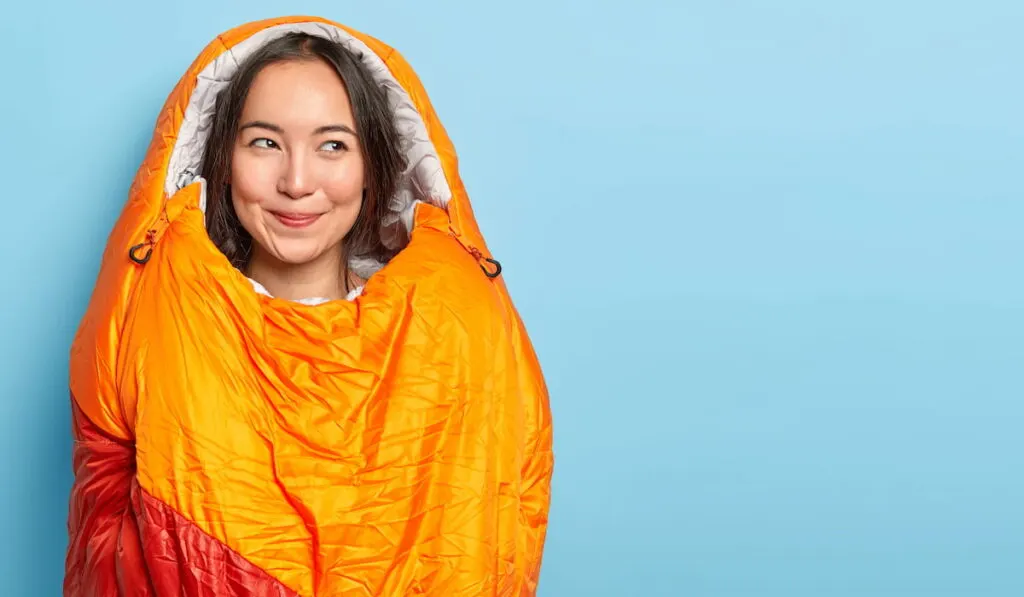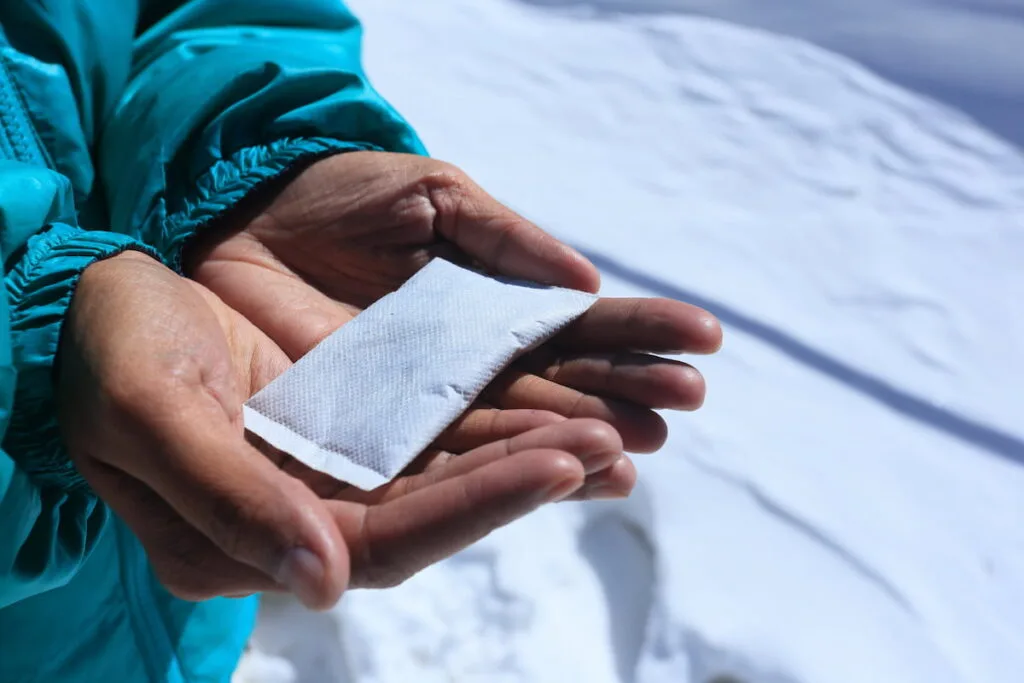If you are an all-year camper preparing for a winter hike, or if it is your first time going on a camping trip, you may wonder how to keep yourself warm and comfortable, especially at night.
Camping in freezing weather can put your health at risk, so it is important to know what you can do to keep yourself warm.

During cold weather, you might notice that what usually gets cold first are your hands and feet. This is a normal occurrence as your body preserves heat for your vital organs, which means that it extracts the heat from your hands and feet to keep your other body parts warm.
After a hike, what you want the most is comfortable sleep. However, it won’t be possible if your feet are cold.
In order to keep your feet warm in a sleeping bag, here are some of tips you can follow:
Table of Contents
How to Keep Your Feet Warm in a Sleeping Bag
1. Use a Hot Water Bottle
A simple way to keep your feet warm is by using a hot water bottle.
The first thing you need to do is to boil some water in a pot. Then, transfer the hot water to a leakproof, heat-resistant bottle.
Simply place that hot water bottle near your feet to keep them warm.
However, this method can be challenging if you do not have the tools to boil water. Therefore, it’s always a good idea to invest in a portable water heater before going on a camping trip.
2. Dress Your Feet
When preparing what clothes to bring, do not forget to bring plenty of socks for your feet.
Preferably, you may want to bring lightweight wicking socks or thick, heavyweight wool socks that will provide insulation at night.
You can also layer these socks, putting the wicking socks underneath the wool socks to trap warm air, thus protecting your feet from the cold.
There are also thermally insulated socks available that work like regular socks, but they also serve as a cushion that keeps your feet warm and comfy at the same time. This type of sock is usually more costly than regular socks.
3. Make Use of Chemical Heat Packs
Perhaps one of the most effortless ways to keep your feet warm at night is by using heat packs. Heat packs are widely available in the United States, especially during winter.
Using them is very simple too.
Before going to sleep, simply open one of those heat packs, then place it at the bottom of your sleeping bag or even inside your socks. In 20 to 30 minutes, you’ll feel them heating up. These usually last throughout the night, with some lasting for 18 hours!
Additionally, you can use these heat packs on your hands and other parts of your body to keep yourself warm.

4. Keep Your Feet Dry
From all the hiking that you’ve done all day, it is inevitable for your feet to sweat. However, that sweat can become cold once the temperature drops.
Therefore, it is important to change your socks once they are covered in sweat. Make sure to do this right before tucking yourself into the sleeping bag.
5. Use High-Quality Sleeping Bags
You might overlook this but picking a sleeping bag that is suitable for your needs will help to keep you warm during camping trips.
Usually, an ordinary sleeping bag does not make a great insulator because it is made of thin fabric.
Therefore, you need to look for a sleeping bag that has a proven temperature rating and good insulation. Usually, these are goose-down or mummy sleeping bags that fit snuggly around your body, thus getting rid of irrelevant space that would get cold.
Another factor to consider when choosing a sleeping bag is to choose those with a synthetic filling that eliminates moisture from accumulating.
You may also want to invest in a sleeping pad to insulate your body warmth.
As a tip, take a look at the R-rating of the pad. This measures the pad’s portability and resistance to heat conduction.
6. Fill the Empty Space of Your Sleeping Bag
The larger the space inside the sleeping bag, the colder it will get inside. Therefore, if you notice that you still have a large empty space around you, you can take out your clothes, spare sleeping bag, or just any item and stuff them around you.
The idea here is to fill the empty spaces in your sleeping bag to enable better insulation, thus keeping your body, including your feet, warm and cozy.
7. Use Foot-Warming Gear
We already talked about socks, but there is also foot-warming gear you can wear to keep your feet warm. There are pads or pouches that you can purchase at camping stores.
These items are usually affordable, lightweight, and easy to carry. They also come in different colors and shapes for you to choose from.
8. Consume Something That Warms Your Body
Whether it is food or liquid, you should consume something that will warm your body, including your feet.

For example, consuming a meal filled with calories will ensure that your body has enough energy to reheat itself, thus helping to keep you warm at night. You can also snack on foods that take a while to digest, such as nuts and meats.
Just make sure to eat at least an hour before tucking yourself in to allow your body to generate heat.
You can also bring teas, powdered hot chocolate, instant coffee, or other hot drinks that are easy to make.
Have a hot drink before bed to ensure that you’ll have a comfortable night’s sleep.
9. Exercise Before Going to Sleep
Going on a camp or a hike is indeed both fun and tiring at the same time. After a long day of walking, all you want at night is to rest your tired feet.
However, exercising before going to bed will enable your muscles to generate heat, thus increasing your body temperature to keep your hands and feet warm.
You don’t need to do complicated exercises. Simple jumping jacks, crunches, or push-ups will be enough to generate heat. Any exercise that pushes your muscles to work is enough.
10. Wrap Your Feet in Clothes or a Blanket

If layering of socks is not enough, or if you don’t bring enough socks to cover your feet, you can instead cover your feet with some clothes or a blanket.
By doing so, you’re adding some extra insulation to your feet, thus keeping them warm.
The thicker the clothes, the better. You can use your coat, jacket, sweater, or even pants.
11. Use Warm Rocks
Another creative yet straightforward way to keep your feet warm is by using a few rocks wrapped in a cloth or socks. If you don’t know, rocks can hold heat much longer than other items.
Choose rocks that are just the right size – not too small to be ineffective and not too big to take up too much space inside your sleeping bag.
Ten to twenty minutes before going to bed, put the rocks near the fire pit to allow them to heat up.
Don’t put the rocks directly on the fire; just put them close enough for them to heat up.
After the rocks get warmed, move them away from the fire to tone down the temperature a little bit. Take extra care when doing this step as rocks tend to get hot very quickly.
Then, wrap the rocks in a cloth or put them inside your old socks. You will need to place them close to your feet to make them effective.
Just make sure to wrap the rocks in clothing to avoid them getting in contact directly with your skin.
12. Wrap Your Feet in a Plastic Bag
A good old method of keeping your feet warm is by wrapping them in a plastic bag.
If you did not bring extra clothes or socks, or if they are drenched in sweat, you can use plastic bags as an alternative measure.
Bonus Tip: Invest in a 4-Season Tent
While tents aren’t known for providing the best insulation, some tents are specifically designed to withstand extreme wintry weather conditions – these are called 4-season tents.
The challenge here is the price – 4-season tents cost more than regular ones.
However, if you are serious about going on camping trips, then we highly recommend that you invest in one of these tents.
Remember, extreme cold can jeopardize your health.
Conclusion
And that wraps up our list of some of the easiest and quickest ways to keep your feet warm in a sleeping bag. If one method does not work, you can try combining several methods until you feel warm and cozy.
Stay safe and warm on your next camping trip!
Resources:
- https://campinghabits.com/warm-feet/
- https://grandcircletrails.com/how-to-keep-feet-warm-in-sleeping-bag/#Hot_water_bottle
- https://headlessnomad.com/how-to-keep-feet-warm-in-sleeping-bag/
- https://outdoorluxuriez.com/camping-tips-for-cold-feet-sleepers-ideas-to-warm-your-feet/
- https://purehiker.com/keep-feet-warm-in-sleeping-bag/
